
Brijmohan Mishra, popularly known as Pandit Birju Maharaj,, is an exponent of the Handia (Rikhipur), Allahabad Kalka-Bindadin gharana of Kathak dance in India. He is a descendant of the Maharaj family of Kathak dancers, which includes his two uncles, Shambhu Maharaj and Lachhu Maharaj, and his father and guru, Acchan Maharaj. Even though dancing is his first love, he practices Hindustani classical music and is a vocalist.
Kumudini Lakhia is an Indian Kathak dancer and choreographer based in Ahmedabad, Gujarat, where she founded Kadamb School of Dance and Music, an institute of Indian dance and music in 1967.
Munna Shukla is a Kathak guru and choreographer of Lucknow Gharana based in New Delhi, India. Born to a family who has been involved in dance for generations, Munna Shukla specializes in Kathak, a classical dance form of North India. He is a grandson of the noted Kathak Maestro, Late Achhan Maharaj, and a nephew of Birju Maharaj.
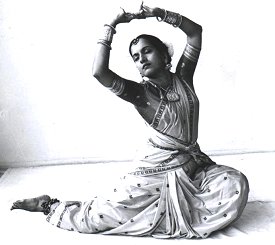
Damayanti Joshi was a noted Indian classical dancer in the Kathak dance form. She began in the 1930s dancing in Madame Menaka's troupe, which travelled to many parts of the world. She learnt Kathak from Sitaram Prasad of Jaipur Gharana and became an adept dancer at a very young age, and later trained under from Acchan Maharaj, Lacchu Maharaj and Shambhu Maharaj of Lucknow gharana, thus imbibing nuances from both the traditions. She became independent in the 1950s and achieved prominence in the 1960s, before turning into a guru at her dance school in Mumbai.

Pandit Durga Lal was a renowned Kathak dancer of the Jaipur Gharana. He was born in Mahendragarh, Rajasthan. He is known for playing the title main role in the 1989 dance drama Ghanashyam; the music of which was composed by Pandit Ravi Shankar and was produced by Birmingham Opera Company. For his contributions to the field of Kathak form of dance he was awarded Padma Shri, the fourth highest civilian award, by Government of India. He had also received the Sangeet Natak Akademi Award for the year 1984.
Shashi Sankhla, , is an exponent of the Jaipur gharana of Kathak dance in India. She is a Senior Disciple of Guru Pt. Kundan Lal Gangani Ji. She has been awarded by Sangeet Natak Akademi Awards 2008 in Kathak dance. She was the principal of Jaipur Kathak Kendra. Her earnest desire to propagate and sustain the classical tenets of Kathak urged her to form Geetanjali music Society an institute devoted to Kathak.
National Institute of Kathak Dance, also known as Kathak Kendra, is the premier dance institution for the Indian classical dance form of Kathak, and a unit of the Sangeet Natak Akademi, India's National Academy of Music, Dance and Drama, situated in New Delhi. Established in 1964, the institution is primarily dedicated to Kathak, though it also offers courses in Hindustani classical music (Vocal) and Pakhawaj.
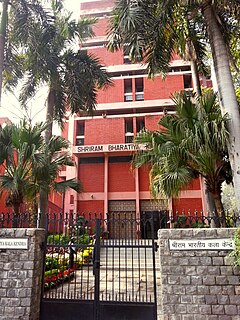
Shriram Bharatiya Kala Kendra (SBKK) is an Indian cultural institution which runs a noted school for music, dance and performing arts in New Delhi. It was founded by Sumitra Charat Ram in 1952, and imparts training in Indian classical dance styles and music, including Kathak, Bharatanatyam, Odissi, Chhau, Hindustani Classical music, both Vocal and Instrumental. It associated organisation is the Shriram Centre for Performing Arts at Safdar Hasmi Marg, in the Mandi House area, the cultural hub of Delhi, the centre includes a theater for the performing arts, a theatre repertory company and an acting school.
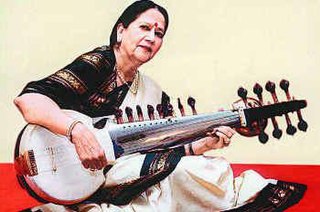
Sharan Rani was an Indian classical sarod player and music scholar.
Lady Irwin School for Girls is an educational institution in New Delhi, India, established in 1927. It is a composite English medium school from class I to class XII affiliated to the Central Board of Secondary Education (CBSE), New Delhi. It has a nursery section.

Shanno Khurana is a noted Indian classical vocalist and composer, from the Rampur-Sahaswan gharana of Hindustani classical music. A disciple of the doyen of the gharana, Ustad Mushtaq Hussain Khan, she is known for performing rare bandish and raag, though her singing style includes genres like khayal, tarana, thumri, dadra, tappa, to chaiti and bhajan. Born and brought up in Jodhpur, she started singing on All India Radio in 1945 in Lahore, later shifted to Delhi, where she continued her singing on All India Radio, Delhi and in concerts and music festivals. She also pursued music education, finally earning her M. Phil. and PhD in music from the Kairagarh University, and has undertakes extensive research on folk music of Rajasthan.
Sumitra Charat Ram was a noted Indian arts patron, impresario and the founder of Shriram Bharatiya Kala Kendra (SBKK) established in 1952. She played a key role in the revival of performing arts, especially Kathak in the post-independence era, with the establishment of Kathak Kendra.
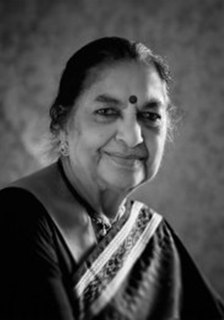
Maya Rao was an Indian classical dancer, choreographer and educator, in Kathak dance. She is known for her pioneering work in Kathak choreography, especially in dance ballets, and is credited for bringing Kathak, a North Indian-dance style to South India, when she opened her dance school, Natya Institute of Kathak and Choreography (NIKC) in Malleswaram, Bangalore in 1987. She was also the founder director of her dance company, "Natya and Stem Dance Kampni", an amalgam of NIKC and the STEM Dance Kampni based in Bangalore. After her early training under Guru Sohanlal of Jaipur Gharana, followed by Guru Sunder Prasad also of the Jaipur Gharana, and went to train under Guru Shambhu Maharaj of Lucknow Gharana at National Institute of Kathak Dance in Delhi.

Rani Karnaa was an Indian classical dancer, known for her proficiency in the Indian dance form of Kathak, and regarded by many as one of the greatest exponents of the art form. She was honoured by the Government of India, in 2014, by bestowing on her the Padma Shri, the fourth highest civilian award, for her services to the field of dance.

Sunayana Hazarilal Agarwal is an Indian classical dancer, known for her expertise in the classical dance form of Kathak and reportedly the only surviving practitioner of the Janakiprasad Gharana of Kathak, also known as Banares Gharana. The Government of India honored her in 2011, with the fourth highest civilian award of Padma Shri.
Roshan Kumari Fakir Mohammad is an Indian classical dancer, actor and choreographer, considered by many as one of the foremost exponents of the Indian classical dance form of Kathak. She follows the Jaipur Gharana and is the founder of Nritya Kala Kendra, Mumbai, an academy promoting Kathak. A recipient of the Sangeet Natak Akademi Award in 1975, she received the fourth highest Indian civilian honour of Padma Shri from the Government of India in 1984.
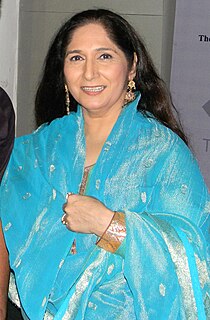
Uma Dogra is an Indian exponent of Kathak, an Indian Classical Dance form. She is the senior most disciple of Pt. Durga Lal, the Kathak Maestro from Jaipur Gharana. She is a Kathak soloist, a choreographer and a teacher. She has been performing in India and abroad for more than 40 years.
Pandit Sunder Prasad was a guru (teacher) of two Gharana (school) - Jaipur Gharana and Lucknow Gharana of the Indian classical dance form, Kathak. He received his training from his father Pandit Chunnilal and Bindadin Maharaj of Jaipur Gharana and Lucknow Gharana respectively.
















